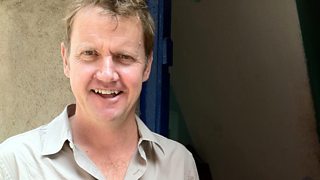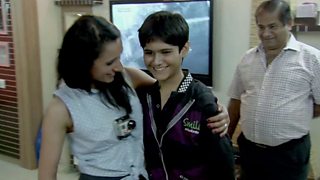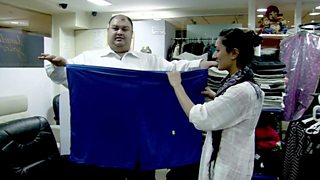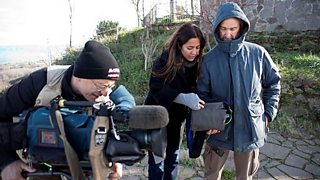India's Supersize Kids
Producer and director Andy Wells writes about the making of India's Supersize Kids.
Our filming in India began during , the Hindu festival of light, which is marked by five days of celebrations and eating. Presenter Anita Rani and I were travelling to Mumbai’s northern suburbs to join a party hosted by the Balani family. The night sky lit by a barrage of fireworks and our drive across the city accompanied by bursts of firecrackers exploding in the streets.

The Balanis' apartment in a middle-class neighbourhood was festooned with Diwali decorations. We were there to meet the family’s son Sagar, who became one of the youngest kids in the world to undergo weight loss surgery when he was just seven years old. The slim young boy we met was unrecognisable from the home video of the child we were shown on a giant TV screen in the living room. At his heaviest, Sagar weighed fourteen stone and could barely walk.
Chubby kids in India are traditionally viewed as a sign of a family's wealth, and ironically, they’re often referred to as “healthy” meaning they’re not malnourished. Even when Sagar was finally put on a diet his mum admitted to us that she would still feed him on the sly. It was only after doctors explained that he was close to eating himself to death that things changed.
The surgeon who operated on Saga was Doctor Shashank Shah. His clinic is a three-hour drive away in the city of Pune, which was once a sleepy backwater but is now a central hub of the country’s booming IT industries. On the dusty outskirts of town we passed more and more building sites and brand new apartment blocks built to accommodate the country’s burgeoning middle-class. Alongside the apartments were scores of roadside billboards offering the services of weight loss clinics.
Fast food
Modern India is place in which half the population is starving whilst the other half is becoming morbidly obese. Any visitor to India’s cities cannot help but be struck by the number of fast food joints and coffee shops as well as the numbers of overweight teenagers in them. Since KFC arrived in the mid-nineties, all of the major fast food chains have followed.
Doctor Shah revealed that ironically the country’s rural population is “protected” by its poverty but that “one out of three Indians in urban areas will have some grade of being overweight or obese”. The clinic carries out ten weight loss surgeries a day and we filmed Doctor Shah perform a gastric sleeve operation on a forty-year-old woman weighing more than twenty two stone. During the keyhole procedure, part of a hormone that makes the patient feel hungry was removed, along with half of the woman’s stomach.
The softly spoken doctor explained how Indians are increasingly suffering from the so-called diseases of the west, including diabetes, which Indians are thought to be genetically prone to. Medical professionals in the country are now bracing themselves for a massive diabetes surge in the next twenty years when they estimate the number of sufferers will reach the 100 million mark.
"Dia-besity" pandemic
Worryingly, half of India’s 1.2 billion population is under twenty five years of age and most at risk from what Doctor Shah describes as the country’s “dia-besity” pandemic. When he started the clinic ten years ago, there were hardly any youngsters coming to see him, but now a quarter of the clinic’s patients are adolescents.
It became clear that this was no longer just a film about fat children and that the emerging story was about diabetes. But finding families with obese children who were willing to talk to me let alone allow me to film them was proving difficult. India is a deeply conservative country where obesity and weight loss surgery is a taboo subject. Particularly among young women worried about disclosure of an operation to the families of prospective husbands.
Kaleb's story��
Thirteen-year-old Kaleb and his mother Dimple couldn’t have been more open with us though. Over the past twelve months Kaleb had tried dieting and exercise but was unable to slim down and was now at his heaviest, weighing seventeen stone.
In many ways Kaleb’s story is typical of many middle class kids in India today.
Being rich in a poor country means children are driven everywhere and games are more likely to be played on a computer than in the street or playground. There’s also huge pressure on academic achievement and this has also led to more sedentary lifestyles.
As a last resort and to stop the onset of diabetes, which the family has a history of, Dimple turned to weight loss surgery for her son. We followed them both to the hospital where Doctor Muffazal Lakdawala fitted Kaleb with a gastric band to reduce the size of his stomach.
Kaleb’s the first thirteen-year-old Doctor Lakdawal has operated on and he refutes the suggestion that he’s providing an easy solution, by saying “This is not a quick fix. It’s the only fix. Every time I operate on a kid this young I just wonder why we couldn’t have done something better”, adding that “If you can teach the kids you’ll save the next generation if not this” generation.
Related links
-
![]()
At his heaviest Sagar weighed fourteen stone and could barely walk.
-
![]()
Anita visits an extra-size clothing store, 'Largely Yours'.
-
![]()
Read more articles from the producers and directors of This World.



